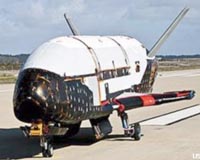 |
Washington (AFP) Dec 17, 2010 NASA carried out tests on the external fuel tank of the aging shuttle Discovery on Friday after strange cracks appeared during a countdown last month which delayed its final launch into space. "So far, so good," said Allard Beutel, a spokesman for the Kennedy Space Center in Florida, adding that there was no immediate sign of the cracks or the hydrogen leak that scuppered the November 5 countdown. "It looks like we're getting good data," said Mike Moses, a launch manager at the US National Aeronautics and Space Administration (NASA). "It's definitely getting us back to a launch posture," he added. Engineers said it would take several days to analyze the results from 89 temperature and tension sensors that were placed on the fuel tank, which was then filled with super-cold liquid hydrogen and liquid oxygen. The tank was to be pressurized to flight levels in a mock countdown later on Friday before it is drained. The sensors will continue to collect results through Saturday as the tank returns to normal temperatures. The instruments are expected to gather at least 6 terabytes of data, the equivalent of three academic research libraries, NASA said in a statement. Engineers are trying to figure out why a pair of "stringers" -- 21-foot-long (6.5 meter) U-shaped aluminum brackets -- cracked during the countdown for the shuttle's last voyage into space. Discovery's final mission to the International Space Station has been delayed until a launch window from February 3-10. If the launch cannot occur at that time another window will open from February 27 to March 3. Another shuttle, Endeavour, is set to take off in April in what will be the last official shuttle launch scheduled for the US program. A third shuttle launch could take place in the summer before the entire fleet is retired for good.
earlier related report The tests are to take place at 7 am (1200 GMT) on the launch pad at NASA's Kennedy Space Center in Florida, the US space agency said in a statement. NASA hopes the results will "help engineers determine what caused the cracks during Discovery's launch countdown on November 5," but warned that the findings would not be immediately released. "Managers and engineers will review the data gathered from the test before determining the next course of action," NASA said. The shuttle Discovery's final mission to the International Space Station has been delayed until February 3 at the earliest. The aging shuttle's latest attempt to launch was scratched on November 5 when technicians found a hydrogen leak and later a series of long cracks on the shuttle's external fuel tank. Experts are puzzled by the cracks, which were found on a pair of 21-foot-long (6.5 meter) U-shaped aluminum brackets called "stringers." The February launch window stays open until the 10th, and if no launch can occur in that time frame, the next window opens February 27 through March 3. The shuttle Endeavour is set to take off in April in what will be the last official shuttle launch scheduled for the US program. A third shuttle launch could take place in the summer before the entire fleet is retired for good.
Share This Article With Planet Earth
Related Links Shuttle at NASA Watch NASA TV via Space.TV Space Shuttle News at Space-Travel.Com
 US military space UAV back on ground after 7 month mission
US military space UAV back on ground after 7 month missionWashington (AFP) Dec 3, 2010 An unmanned US Air Force spacecraft with a vaguely defined military mission landed early Friday in California after a seven-month mission, officials said. The X-37B, the US Air Force's first unmanned re-entry spacecraft, landed at Vandenberg Air Force Base at 1:16 am local time (0932 GMT), according to an Air Force statement. The orbital spacecraft "conducted on-orbit experiments for mor ... read more |
|
| The content herein, unless otherwise known to be public domain, are Copyright 1995-2010 - SpaceDaily. AFP and UPI Wire Stories are copyright Agence France-Presse and United Press International. ESA Portal Reports are copyright European Space Agency. All NASA sourced material is public domain. Additional copyrights may apply in whole or part to other bona fide parties. Advertising does not imply endorsement,agreement or approval of any opinions, statements or information provided by SpaceDaily on any Web page published or hosted by SpaceDaily. Privacy Statement |